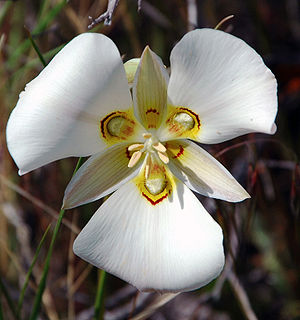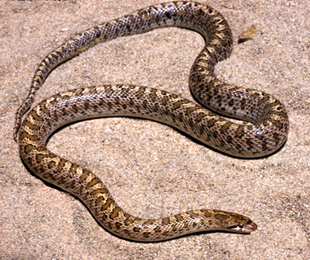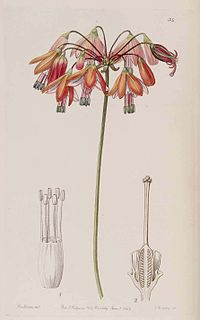Related Research Articles

Eschscholzia is a genus of 12 annual or perennial plants in the Papaveraceae (poppy) family. The genus was named after the Baltic German/Imperial Russian botanist Johann Friedrich von Eschscholtz (1793-1831). All species are native to Mexico or the southern United States.

The king rail is a waterbird, the largest North American rail.

Calochortus is a genus of North American plants in the lily family. The group includes herbaceous, perennial and bulbous species, all native to North America.

Arizona elegans is a species of medium-sized colubrid snake commonly referred to as the glossy snake or the faded snake, which is endemic to the southwestern United States and Mexico. It has several subspecies. Some have recommended that A. elegans occidentalis be granted full species status.

Bessera is a genus of Mexican plants in the cluster lily subfamily within the asparagus family. It is a small genus of 3 known species of mostly herbaceous flowering plants with corms. They have flowers with petals and petaloid sepals (tepals) with compound pistils.

The elegant crested tinamou or martineta tinamou is a medium-sized tinamou that can be found in southern Chile and Argentina in shrubland.

Caenorhabditis is a genus of nematodes which live in bacteria-rich environments like compost piles, decaying dead animals and rotting fruit. The name comes from Greek: caeno- ; rhabditis = rod-like. In 1900, Maupas initially named the species Rhabditis elegans, Osche placed it in the subgenus Caenorhabditis in 1952, and in 1955, Dougherty raised Caenorhabditis to the status of genus.

The buff-spotted flufftail is a species of bird in the family Sarothruridae. It is found in Angola, Botswana, Burundi, Cameroon, Republic of the Congo, Democratic Republic of the Congo, Ivory Coast, Equatorial Guinea, Ethiopia, Gabon, Guinea, Kenya, Liberia, Malawi, Mozambique, Nigeria, Rwanda, Sierra Leone, Somalia, South Africa, South Sudan, Swaziland, Tanzania, Uganda, Zambia, and Zimbabwe.

The southern martin is a species of bird in the family Hirundinidae.

Eudromia is a genus of birds in the tinamou family. This genus comprises two crested members of this South American family.

Heuchera elegans is a species of flowering plant in the saxifrage family known by the common name urn-flowered alumroot.
Elegans, elegant in Latin, may refer to:

Echeveria elegans, the Mexican snow ball, Mexican gem or white Mexican rose. is a species of flowering plant in the family Crassulaceae, native to semi-desert habitats in Mexico.

Gibbonsia elegans, the spotted kelpfish, is a species of clinid native to subtropical waters of the Pacific Ocean from central California, U.S. to southern Baja California, Mexico. It prefers subtidal rocky habitats with seaweed down to a depth of about 56 metres (184 ft). This species can reach a maximum length of 16 centimetres (6.3 in) TL. This species feeds on benthic crustaceans, gastropods, and polychaete worms. Gibbonsia is named after Dr. William P. Gibbsons who was a naturalist in the California Academy of Science. It is found in three different colors depending on their habitat. Males and females do not show sexual dimorphism.
C. elegans most commonly refers to the model round worm Caenorhabditis elegans. It may also refer to any of the species below. They are listed, first in taxonomic order and, second, alphabetically.

Paracymus is a genus of hydrophilid beetles with 81 species worldwide.
Paracymus despectus is a species of water scavenger beetle in the family Hydrophilidae. It is found in North America.
Paracymus confluens is a species of water scavenger beetle in the family Hydrophilidae. It is found in North America.
Paracymus nanus is a species of water scavenger beetle in the family Hydrophilidae. It is found in the Caribbean and North America.
Paracymus subcupreus is a species of water scavenger beetle in the family Hydrophilidae. It is found in North America.
References
- ↑ List of the Coleoptera of Southern California: With Notes on Habits and Distribution and Descriptions of New Species. HC Fall, 1901, page 12, doi:10.5962/bhl.title.21902
